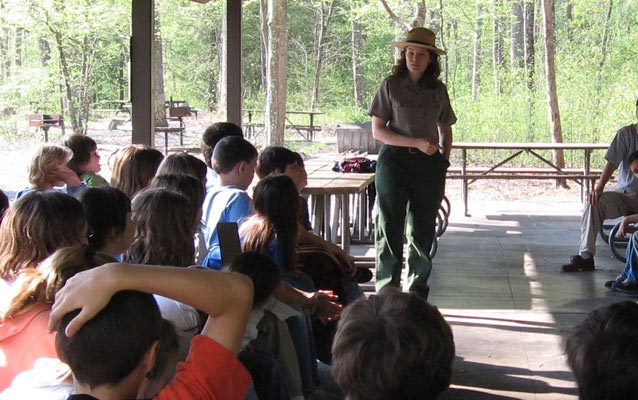Lesson Plan

NPS Photo
- Grade Level:
- Second Grade-Fourth Grade
- Subject:
- Biodiversity, Ecology
- Duration:
- 30 minutes
- Group Size:
- Up to 36
- Setting:
- classroom
- National/State Standards:
- SCIENCE
3.L.2.1
3.L.2.2
3.L.2.3
3.L.2.4 - Keywords:
- Great Smoky Mountains National Park, third grade, food chain, carnivore, herbivore, omnivore
Overview
Habitats are numerous and diverse within Great Smoky Mountains National Park. Animals and plants alike need habitats. Habitats will be defined and students will take time to seek out clues from animals sharing habitats.This unit is broken into three parts. The overall unit involves a trip to the park and is accompanied by one preparation activity and one wrap-up activity. This is the field preparation activity of the unit.
Objective(s)
1) Explain ways plants and animals need and interact with one another.
2) Understand what a food chain is and their own place in one.
3) Understand what happens when a food chain is disrupted.
Background
The park’s fundamental significance is that it is a sanctuary for a remarkably diverse array of native plants and animals. Today a large part of Great Smoky Mountains National Park is a relatively undisturbed ecosystem, in sharp contrast to nearly every other land area of the Eastern United States. The undisturbed ecosystem values include natural communities with endemic gene pools providing opportunities for scientific research and education. These natural systems can be used as an indicator of change occurring locally, regionally, nationally, and internationally. Understanding food webs and monitoring their elements is one way to assess the health of a habitat. In this activity, students will connect components of a food web, while understanding that a food chain is the flow of energy from plants (producers) to other animals (consumers).
Teachers coming on the accompanying field trip should download our complete field trip packet that includes all of the lessons: What Makes the Great Smokies Great pre-site lesson, information and directions about the field trip and What Makes the Great Smokies Great Wrap-up post site lesson.
Download the full What Makes the Great Smokies Great Field Trip packet (includes Preparation and Wrap-up lessons).
Materials
This lesson includes instructions for the food chain game and a Pre and Post Site Test.
-
Food Chain Card Game
Students complete a food chain with producers and consumers. Download
-
What Makes the Great Smokies Great - Pre and Post Site Test
Pre site test to be used before the field trip and a post site test to use after the field trip. Download
Procedure
Step 1: Arrange students in a circle.
Step 2: Pass out the food chain cards (one per student), select one student to be the soil.
Step 3: Give the end of the ball of yarn to this student. With the student holding the end, ask them to toss the yarn to the next food chain components which depend on the soil.
Step 4: The final student in the producers should toss the yarn to the consumers of producers.
Step 5: These students will then toss the ball to the next level of consumers (carnivores). The yarn will be crisscrossed across the circle to show the complexity of a food web.
Assessment
Administer a pre and post site test that is included in the unit.
Park Connections
The fundamental significance of Great Smoky Mountains National Park is that it is a sanctuary for a remarkable diverse array of native plants and animals. Today a large part of Great Smoky Mountains National Park is a relatively undisturbed ecosystem, in sharp contrast to nearly every other land area of the Eastern United States. The undisturbed ecosystem’s values include natural communities with endemic gene pools which provide opportunities for scientific research and education. These natural systems can be used as an indicator of change occurring locally, regionally, nationally and internationally.
Vocabulary
carnivore, consumer, energy web, food web, herbivore, omnivore, predator, prey, producer, scavengerLast updated: April 14, 2015
